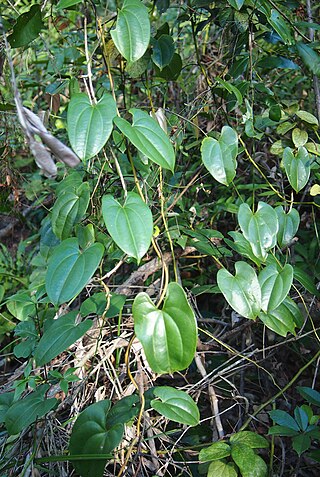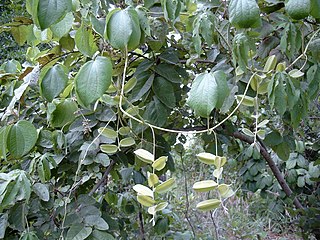
Tropical and subtropical moist broadleaf forests (TSMF), also known as tropical moist forest, is a subtropical and tropical forest habitat type defined by the World Wide Fund for Nature.

Dioscorea alata, also known as purple yam, ube, or greater yam, among many other names, is a species of yam. The tubers are usually a vivid violet-purple to bright lavender in color, but some range in color from cream to plain white. It is sometimes confused with taro and the Okinawa sweet potato beniimo (紅芋), however D. alata is also grown in Okinawa. With its origins in the Asian tropics, D. alata has been known to humans since ancient times.

Dioscorea is a genus of over 600 species of flowering plants in the family Dioscoreaceae, native throughout the tropical and warm temperate regions of the world. The vast majority of the species are tropical, with only a few species extending into temperate climates. It was named by the monk Charles Plumier after the ancient Greek physician and botanist Dioscorides.

Dioscorea villosa is a species of twining tuberous vine which is native to eastern North America. It is commonly known as wild yam, colic root, rheumatism root, devil's bones, and fourleaf yam. It is common and widespread in a range stretching from Texas and Florida north to Minnesota, Ontario and Massachusetts.

The red river hog or bushpig, is a wild member of the pig family living in Africa, with most of its distribution in the Guinean and Congolian forests. It is rarely seen away from rainforests, and generally prefers areas near rivers or swamps.

Dioscorea communis or Tamus communis is a species of flowering plant in the yam family Dioscoreaceae and is commonly known as black bryony, lady's-seal or black bindweed.

Yam is the common name for some plant species in the genus Dioscorea that form edible tubers. The tubers of some other species in the genus, such as D. communis, are toxic. Yams are perennial herbaceous vines cultivated for the consumption of their starchy tubers in many temperate and tropical regions, especially in West Africa, South America and the Caribbean, Asia, and Oceania. The tubers themselves, also called "yams", come in a variety of forms owing to numerous cultivars and related species.

Dioscorea polystachya or Chinese yam, also called cinnamon-vine, is a species of flowering plant in the yam family. It is sometimes called Chinese potato or by its Korean name ma. It is also called huaishan in Mandarin and waisan in Cantonese.

Dioscorea bulbifera is a species of true yam in the yam family, Dioscoreaceae. It is native to Africa, Asia and northern Australia. It is widely cultivated and has become naturalized in many regions.

Diosgenin, a phytosteroid sapogenin, is the product of hydrolysis by acids, strong bases, or enzymes of saponins, extracted from the tubers of Dioscorea wild yam species, such as the Kokoro. The sugar-free (aglycone) product of such hydrolysis, diosgenin is used for the commercial synthesis of cortisone, pregnenolone, progesterone, and other steroid products.

Dioscorea esculenta, commonly known as the lesser yam, is a yam species native to Island Southeast Asia and introduced to Near Oceania and East Africa by early Austronesian voyagers. It is grown for their edible tubers, though it has smaller tubers than the more widely-cultivated Dioscorea alata and is usually spiny.

Dioscorea transversa, the pencil yam, is a vine of eastern and northern Australia.

Dioscorea cayenensis subsp. rotundata, commonly known as the white yam, West African yam, Guinea yam, or white ñame, is a subspecies of yam native to Africa. It is one of the most important cultivated yams. Kokoro is one of its most important cultivars.
Wild yam is a common name for several plants and may refer to:

Nigeria is by far the world’s largest producer of yams, accounting for over 70–76 percent of the world production. According to the Food and Agriculture Organization report, in 1985, Nigeria produced 18.3 million tonnes of yam from 1.5 million hectares, representing 73.8 percent of total yam production in Africa. According to 2008 figures, yam production in Nigeria has nearly doubled since 1985, with Nigeria producing 35.017 million metric tonnes with value equivalent of US$5.654 billion. In perspective, the world's second and third largest producers of yams, Côte d'Ivoire and Ghana, only produced 6.9 and 4.8 million tonnes of yams in 2008 respectively. According to the International Institute of Tropical Agriculture, Nigeria accounted for about 70 percent of the world production amounting to 17 million tonnes from land area 2,837,000 hectares under yam cultivation.

Dioscorea japonica, known as East Asian mountain yam, yamaimo, or Japanese mountain yam, is a type of yam (Dioscorea) native to Japan, Korea, China, Taiwan, and Assam.

Dioscorine is an alkaloid toxin isolated from the tubers of tropical yam on several continents. It has been used as a monkey poison in some African countries, and as an arrow poison to aid in hunting in several parts of Asia. It was first isolated from Dioscorea hirsute by Boorsma in 1894 and obtained in a crystalline form by Schutte in 1897, and has since been found in other Dioscorea species. Dioscorine is a neurotoxin that acts by blocking the nicotinic acetylcholine receptor. Dioscorine is generally isolated in tandem with other alkaloids such as dioscin but is usually the most potent toxin in the mixture. It is a convulsant, producing symptoms similar to picrotoxin, with which it shares a similar mechanism of action.

Dioscorea dumetorum, also known as the bitter yam, cluster yam, trifoliate yam, or three-leaved yam, is a species of flowering plant in the yam family, Dioscorea. It is native to sub-saharan Africa and especially common in the tropical regions of West Africa, including Nigeria, Benin, and Ghana. D. dumetorum has both toxic and non-toxic varieties.
Dioscorea pseudomacrocapsa is a species of yam in the family Dioscoreaceae. It occurs in southeastern Brazil, and grows in tropical rainforests.
Dioscorea cayenensis is a species of yam in the genus Dioscorea that is a widely consumed West African domesticated crop. Dioscorea rotundata is sometimes treated as a subspecies, and sometimes also as a separate species. Common names include Guinea yam, yellow yam, and yellow Guinea yam.
















